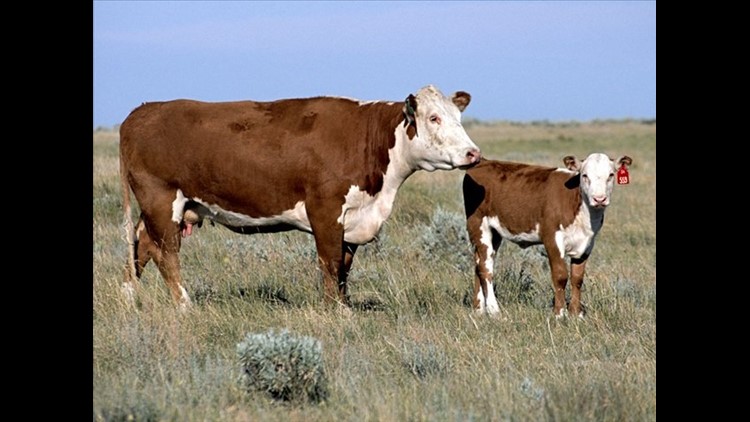(CNN) — In 2014, an estimated 9.6 million people were infected by tuberculosis, according to the World Health Organization. Potentially fatal — 1.5 million died from it the same year — it is a disease known to be spread from human to human. But a subset of those contracting the disease today are getting it from infected animals.
Unbeknownst to many, tuberculosis can spread through your food, as well as the air, via infected animals. The most common culprits? Infected cattle.
Cows and many other animals can harbor bovine tuberculosis (TB), a disease caused by infection with Mycobacterium bovis — a close relative of the bacteria that cause human tuberculosis. Risk of human disease rises when animal infections aren’t controlled.
Colleen Scott, Epidemic Intelligence Service Officer at the U.S. Centers for Disease Control and Prevention (CDC), says the highest rates of bovine TB cases in the United States are found along the U.S.-Mexican border.
During a symposium at the 46th World Conference on Lung Health in Cape Town, South Africa, in early December, Scott presented new findings that showed that cases of bovine TB in the United States were found to be significantly higher among Hispanic communities. According to Scott, up to 44% of Hispanic people infected with TB were found to have the bovine form of the disease.
“What we’re seeing is they are getting it from ingestion of unpasteurized milk products,” she says.
Those products are unpasteurized milk itself, but also raw cheeses — known as “queso fresco” — that are made with milk from infected herds.
Scott’s analysis investigated all reported cases of TB in the United States from 2006 to 2013 and found 1.5% of all cases in this time period to be infected with bovine TB. According to the CDC, up to 230 cases of TB in the United States each year are attributable to this form of the disease.
Globally, the rate is thought to be similar — at 1.4%% — with estimates of more than 120,000 cases of bovine TB in humans each year.
Raw milk and cheese
“Forty per cent of milk and dairy products in Mexico are consumed unpasteurized,” says Alejandro Pereira-Ortiz, from the U.S. Department of Agriculture’s base in Mexico, a country where unpasteurized cheese is prized for its flavor. “I see infected cattle herds and people eating fresh cheese and drinking fresh milk,” says Pereira-Ortiz, who also presented at the conference.
Programs are in place to control infections among commercial cattle exported to countries like the United States — typically beef herds — but controls are often not applied to smaller-scale dairy herds according to Pereira-Ortiz.
Research in Ecuador, also presented at the conference, found up to 65% of herds screened as part of the study to be infected with bovine TB.
Cattle found to be infected are typically slaughtered but in many low income countries there is no financial compensation for slaughtered cattle, so cases of Bovine TB are often not reported.
A global problem
The existence of Bovine TB among animals and humans is not unique to the Americas. The disease is found globally, particularly in Africa and parts of Asia, and in a 2012 study by the International Livestock Research Institute, more than 7% of livestock screened globally tested positive for the disease.
“[In India] people are very intimately associated with their cows … we look after the cattle, men sleep in the area where cattle are tethered … the proximity is very close,” says Krishna Prasad Hanumanthappa from the All India Institute of Medical Sciences, New Delhi. Hanumanthappa has seen the presence of both regular and bovine TB cow milk in India. Here, however, he says ingestion is not the main concern.
“The practice of boiling milk has been one of the greatest safeguards we’ve had on transmission,” says Hanumanthappa. He instead worries about the disease spreading through other means.
“[Bacteria] can be excreted through fecal matter, urine, coughs, and sneezes,” he explains.
In most countries in Africa, bovine TB is endemic, but experts say regular milk pasteurization and slaughterhouse meat inspections are rare.
“We used to see a lot of cattle slaughtered with TB lesions in the lungs of the animals … and locals eat these products,” says Simeon Cadmus, from the University of Ibadan, Nigeria. His recent study of a sample of livestock workers in Nigeria found 6-7% of traders and butchers to be infected with TB of some kind. Document? — in attached highlights,
Cadmeus also worries about people rearing cattle who live closely with their cows. “They eat, drink and stay all their lives with their cattle,” says Cadmeus who adds that further studies of his among herds have found 40-60% of cattle infected. “Because of poor animal health issues … the pastoralists also get infected,” he says.
Infecting all animals
Despite the name bovine TB, the bacteria behind the infection infect a wide range of animals, including deer, elk, meerkats and lions, making those animals reservoirs of the disease. “We have found bovine TB in two dozen mammal species in South Africa and I would guess a form of TB could be found in every mammal,” says Paul Van Helden, director of the MRC Center for TB research, in South Africa.
“People didn’t think it would spread, but it has,” says Van Helden. His concern is the lack of routine screening for this form of the disease. Public health programs continue to screen mainly for Mycobacterium tuberculosis — the human form of the disease. “If we don’t know how much we have, we don’t know how to prioritize it,” says Van Helden.
Getting from food into the air
Tuberculosis is a complicated disease with the ability to infect not only the lungs, but other parts of the body — known as extra pulmonary TB. This latter form of the disease is common among bovine TB infections and is harder to diagnose in humans as the most common tests — which analyze a person’s sputum — cannot detect it.
Two thirds of the U.S. cases identified in Scott’s data had the extra-pulmonary form of TB, which cannot be spread by coughs and sneezes. But researchers in the field are now concerned about the remaining third; they suspect the pulmonary form of bovine TB could spread between humans.
“The question now is whether [this] can be transmitted through the airborne route,” says Scott. If so, control measures will need to changed.
The World Health Organization launched its End TB strategy in 2015, setting a target to eliminate TB by 2035 — just 20 years away. Though only a small percentage of people with TB are infected with the bovine form, researchers say they need to be factored in if TB is to be eliminated.
“Once we have transmission through the pulmonary route, these people will travel and the bug will spread out,” says Cadmeus. “That’s why we must do something now.”



